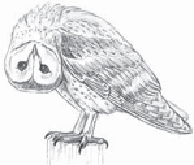Biology Reference
In-Depth Information
which trails are most likely to lead to a meal. How do we know this? Finnish research-
ers put out fresh trails of rodent urine in an experimental field and found that Eurasian
Kestrels hunted along these trails. In the laboratory, kestrels spent more time hovering
above and inspecting urine-treated paths illuminated by UV light than those illuminated
by artificial white light.
Q I read that Peregrine Falcons can dive toward a duck at speeds of over 100 miles
per hour. How do they protect their eyes from dust and insects, and from simply
drying out, at such high speeds?
A
You're right that keeping eyes lubricated and dust free are important issues for birds.
Birds have a translucent, semitransparent inner eyelid called the nictitating membrane
that sweeps across the surface of the eye, allowing them to blink without blocking their
view. Some birds, especially diving species such as loons and some ducks, have a clear
“window” in the middle of the nictitating membrane that they probably use as we do
goggles to improve underwater vision.
In addition, birds have two different tear glands. The lacrimal gland has many tear
ducts along the lower eyelid. There is a second tear gland at the base of the nictitating
membrane to maximize lubrication as that membrane blinks.
Q I spend a lot of time watching birds. On TV I see hawks and owls holding their
heads upside down when looking at something, but I never see them do that in
nature. Why?
A
Virtually all birds and lizards, and also primates, have an area of the retina called the
fovea
, where vision is especially keen. The fovea of hawks and owls is above the mid-
line, so from high perches or in flight they can see objects far below especially keenly.
This is important because their food is normally found below, and they seldom need to
see objects above their heads as clearly. Those TV hawks and owls holding their heads
upside down are almost always captive birds, perched much lower than they would be in
the wild inthe presence ofaphotographer.When something looms above abird'snormal
field of view and the bird can't change its position, it holds its head upside down to get
the object in the fovea.





